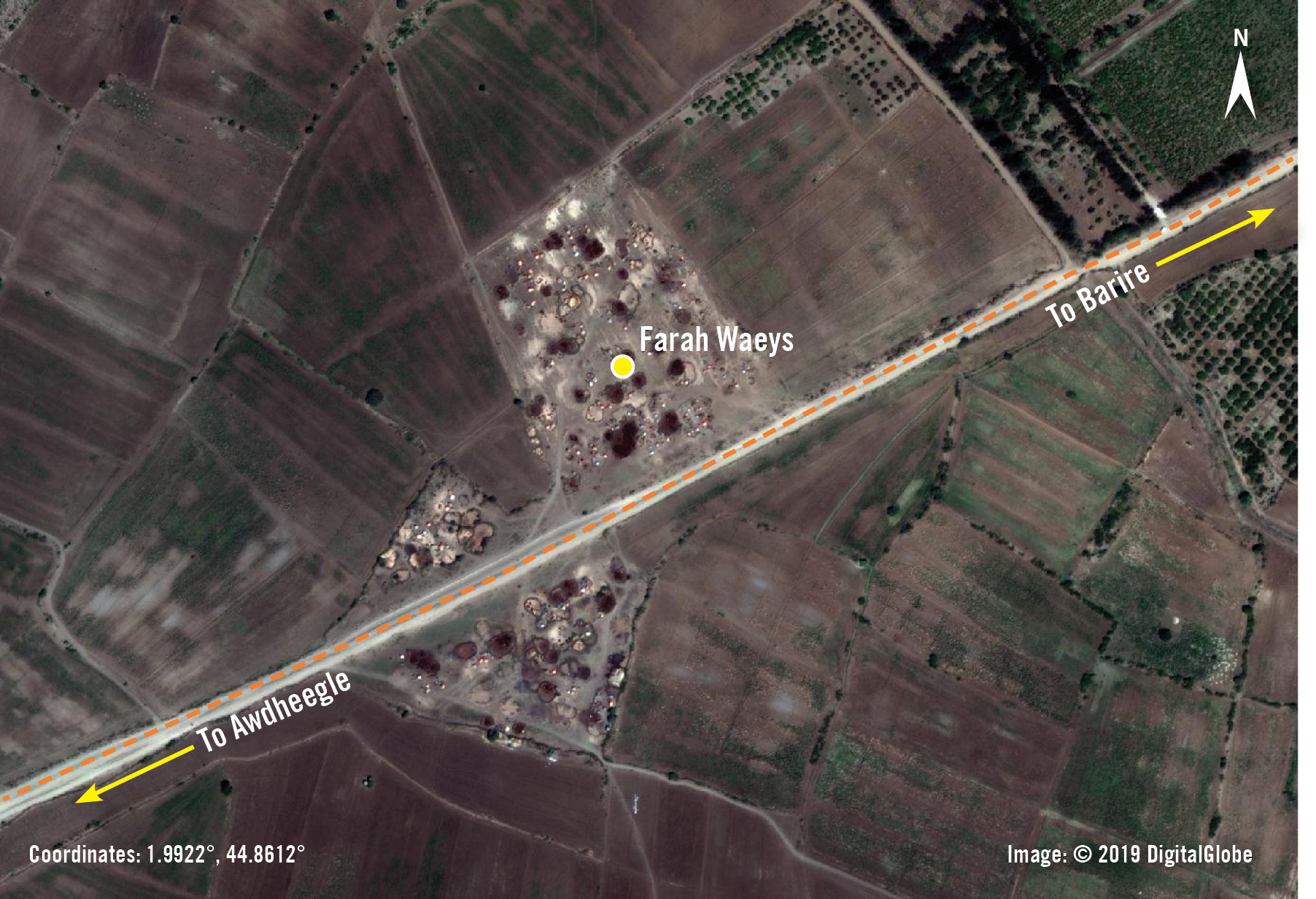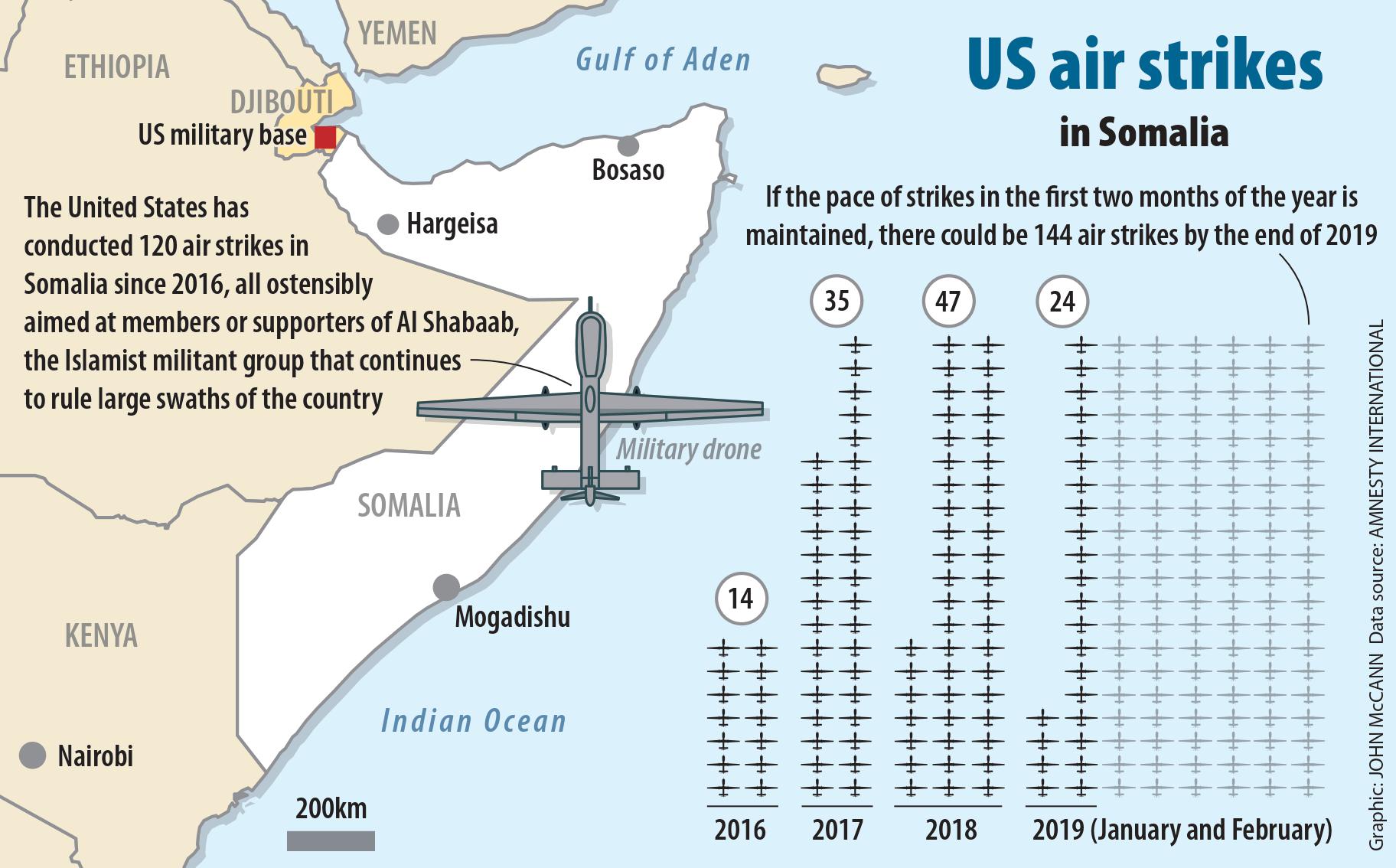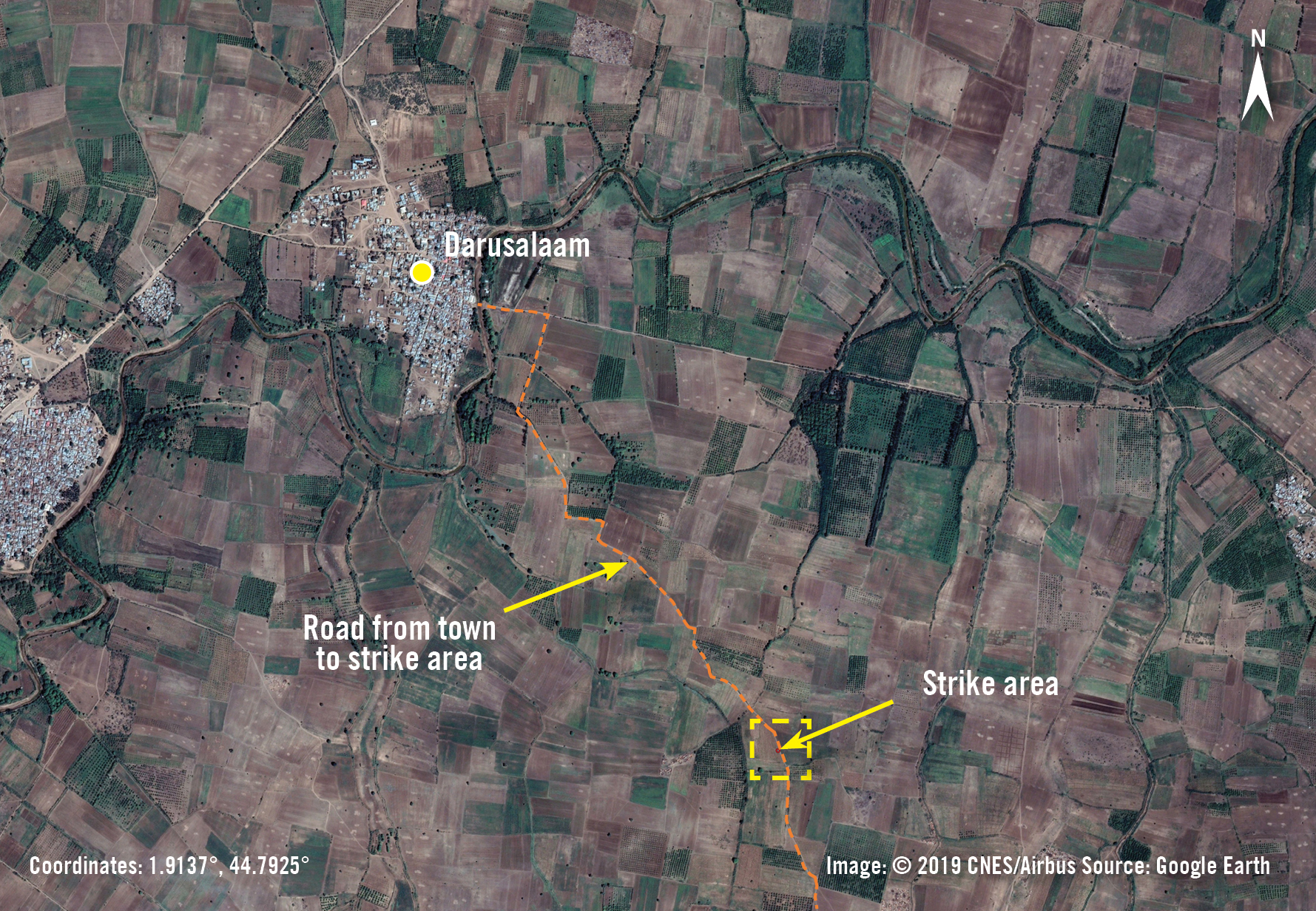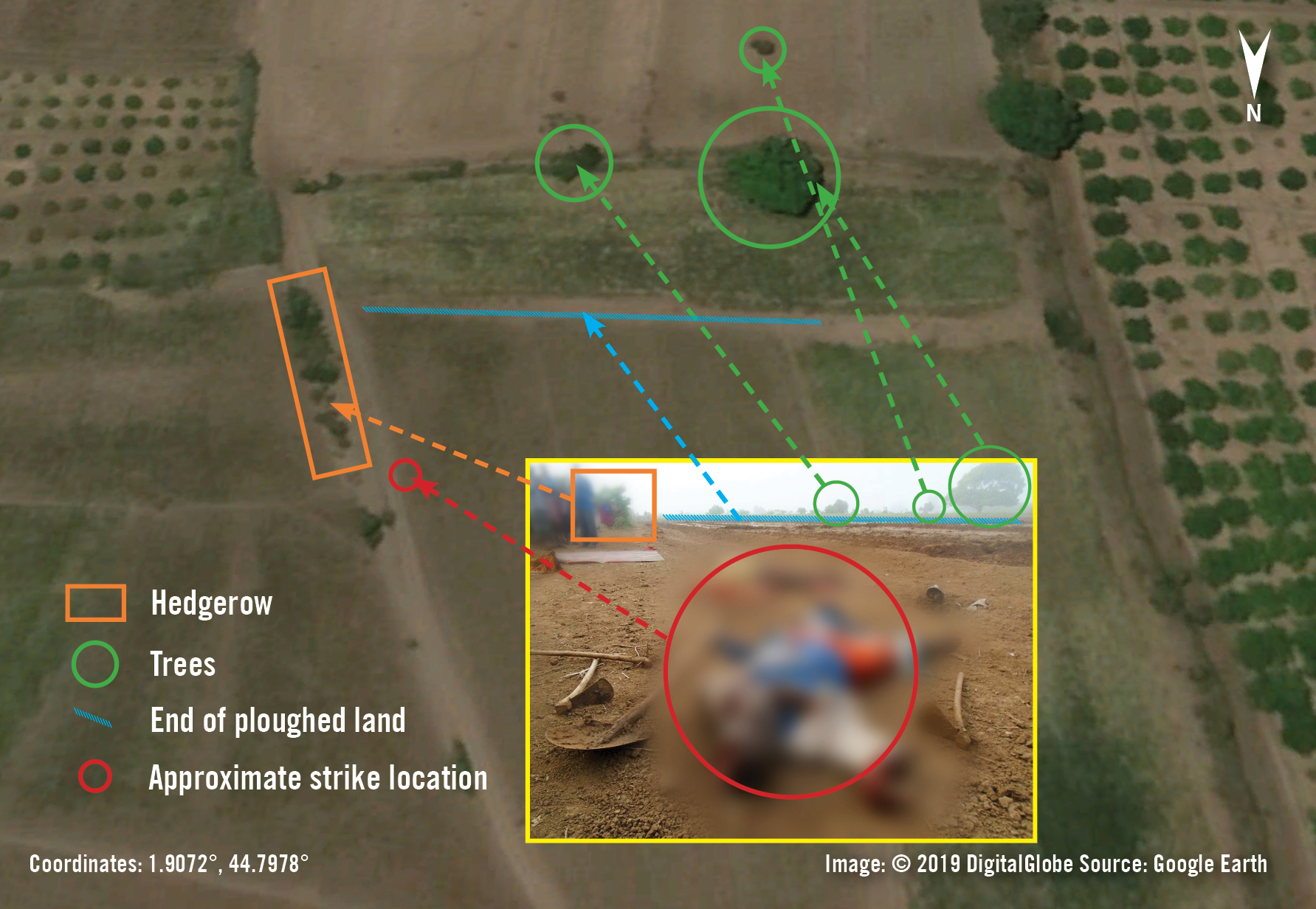Geolocation of a US air strike area. (Image: Amnesty)
NEWS ANALYSIS
In June 2018, the United States department of defence confidently told the United States Congress that its military operations in Somalia — including air strikes — had resulted in zero civilian casualties in 2017.
But it was lying, according to a new report from Amnesty International.
The report, released on Wednesday, describes a massive increase in the US military’s bombing campaign in Somalia since President Donald Trump became president, with more than 100 air strikes by both drones and manned aircraft since early 2017.

According to Amnesty’s investigation into just five of these incidents, at least 14 civilians were killed, including five children. The full civilian death toll is likely to be much higher, Amnesty concluded.
“The civilian death toll we’ve uncovered in just a handful of strikes suggests the shroud of secrecy surrounding the US role in Somalia’s war is actually a smokescreen for impunity,” said Brian Castner, an Amnesty International researcher. “Our findings directly contradict the US military’s mantra of zero civilian casualties in Somalia. That claim seems all the more fanciful when you consider the USA has tripled its air strikes across the country since 2016, outstripping their strikes in Libya and Yemen combined.”

The United States conducted 14 air strikes in Somalia in 2016, all ostensibly aimed at members or supporters of al-Shabaab, the Islamist militant group that continues to rule large swathes of the country. This rose to at least 35 air strikes in 2017, and at least 47 in 2018, according to Amnesty.
In a response to Amnesty, Africom said that Amnesty’s findings ““do not appear likely based on contradictory intelligence that cannot be disclosed because of operational security limitations”.
All military-aged males are now considered military targets
The sudden and dramatic increase in US military involvement in Somalia came in direct response to one of Trump’s earliest presidential directives. The full text of the directive has not been made public: all we know for sure is that it designated Somalia as an “area of active hostilities”, and significantly loosened the US military’s rules of engagement there.
These rules have become so loose that virtually all military-age men in al-Shabaab-controlled areas are now considered legitimate targets, said a retired general interviewed by Amnesty. Until his retirement in mid-2017, retired Brigadier General Donald Bolduc was a commander with the US military’s Africa Command (Africom).
Africom has disputed Bolduc’s interpretation, but refused to say how how targeting standards are actually applied, citing security reasons.
“If General Bolduc is accurate in how the policy is practically applied, then such an approach to targeting would be contrary to international humanitarian law,” said Amnesty.
Beyond Black Hawk Down
The United States has a long and ignominious history of intervening in Somalia. Everyone remembers Black Hawk Down — the downing of the American chopper in 1993 was broadcast across the world, as were the images of American corpses being dragged through the streets of Mogadishu. The incident left such a scar on the superpower’s psyche that it fundamentally altered America’s risk threshold, contributing to Washington’s decision not to get involved in Rwanda a year later.
For Somalia, another American intervention would have far more wide-reaching consequences. In 2006, the country was mostly under the control of the Islamic Courts Union, a conservative Islamist group that was far too Islamist for the administration of George W. Bush Jr., then in the early stages of what would become the global “war on terror”.
The US supported an Ethiopian invasion to get rid of the Islamic courts. It worked, at least in the short term: the Islamist group was removed from power and mostly destroyed. But hardline elements within the group, embittered and ultimately emboldened by the invasion, went on to form a far more radical and far more dangerous organisation known as al-Shabaab.
America’s war against al-Shabaab began almost immediately, with three air strikes in 2007 that killed 21 people. It has continued ever since, in the form of bombing raids, drone attacks and even the very occasional ground operation.
Nothing seems to have worked, however: although its fortunes have waxed and waned, al-Shabaab remains a potent force. As recently as three weeks ago, on March 1, al-Shabaab fighters seized several buildings in central Mogadishu. Security forces took a full day to clear the buildings, with 24 people — mostly civilians — dead by the time order had been restored.
Time and time again, both the Somalia National Army and the relatively well-resourced African Union Mission in Somalia have proved powerless to prevent such attacks. Nor have US air strikes made much of a difference — as the US itself clearly understands.
“At the end of the day, these strikes are not going to defeat al-Shabaab,” admitted General Thomas Waldhauser, the head of Africom, at an appearance before the US Congress last month. This has not stopped him from ordering more air strikes on Somalia than anyone else in history, however.
“We’ve been waiting for someone to ask”
In yet another Congressional briefing, in March 2018, General Waldhauser let something slip. “I wouldn’t characterise that we’re at war [in Somalia]. It’s specifically designed for us not to own that,” he said.
That ‘specific design’ relies on air strikes, usually from unmanned aerial vehicles. Using drones allows the US to bomb Somalia at arm’s length, without ever having to admit that it is “at war” in the Horn of Africa.
But for the Somalis on the receiving end of the American ordnance, it certainly feels like war.
“We have been waiting for someone to come ask us about this,” said Liban, a resident of Darussalam village, which was bombed in November 2017. Amnesty International’s investigation concluded that three farmers — all civilians — were killed in the attack, while they were camping under a tree, probably watching a Bollywood movie on a mobile phone that had to be kept hidden from al-Shabaab. Their findings were based on in-person interviews with 18 residents of the village and its vicinity, including six eyewitnesses.

“I saw the heavy splashing light and then the big noise came, and I fell down,” said Liban. “when the noise [of an airstrike] happened everything ceased…I was so frightened. I couldn’t keep watch on the farm at all. I went under the shelter of the tree and hid.” In the morning, when he went to check on his fellow farmers, they were dead.

Africom disputes this version of events. “Africom conducted a precision-guided strike that corresponds to the time and location alleged, targeting al-Shabaab fighters,” it told Amnesty. Its own assessment of the attack “determined that the three men described in the allegation were not sleeping at the time of the strike and were members of al-Shabaab”.
But Africom also disputes that it is at war in Somalia. The routine use of drone strikes, and the increasing civilian casualty count, tell a very different story.